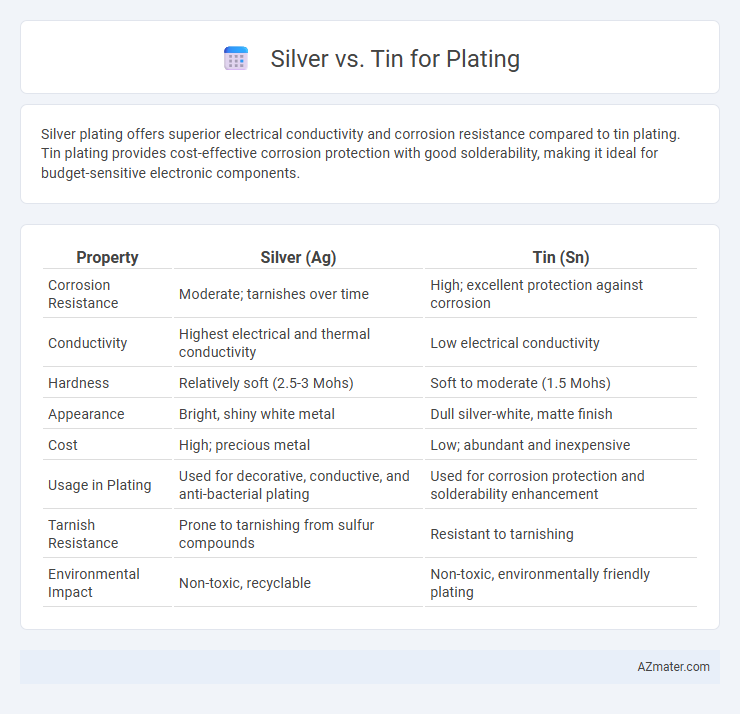Silver plating offers superior electrical conductivity and corrosion resistance compared to tin plating. Tin plating provides cost-effective corrosion protection with good solderability, making it ideal for budget-sensitive electronic components.
Table of Comparison
| Property | Silver (Ag) | Tin (Sn) |
|---|---|---|
| Corrosion Resistance | Moderate; tarnishes over time | High; excellent protection against corrosion |
| Conductivity | Highest electrical and thermal conductivity | Low electrical conductivity |
| Hardness | Relatively soft (2.5-3 Mohs) | Soft to moderate (1.5 Mohs) |
| Appearance | Bright, shiny white metal | Dull silver-white, matte finish |
| Cost | High; precious metal | Low; abundant and inexpensive |
| Usage in Plating | Used for decorative, conductive, and anti-bacterial plating | Used for corrosion protection and solderability enhancement |
| Tarnish Resistance | Prone to tarnishing from sulfur compounds | Resistant to tarnishing |
| Environmental Impact | Non-toxic, recyclable | Non-toxic, environmentally friendly plating |
Introduction to Metal Plating: Silver vs Tin
Silver and tin are widely used metals for plating due to their distinct properties and applications. Silver plating offers superior conductivity, corrosion resistance, and a bright, attractive finish ideal for electronics and jewelry. Tin plating provides excellent solderability, corrosion protection, and cost-effectiveness, making it popular in the food industry and electrical contacts.
Key Properties of Silver and Tin Plating
Silver plating offers excellent electrical conductivity, high corrosion resistance, and superior thermal conductivity, making it ideal for electronic connectors and contacts. Tin plating provides good solderability, corrosion resistance against mild environments, and cost-effectiveness, frequently used in food packaging and electronic components. Silver's higher hardness and aesthetic appeal contrast with tin's flexibility and resistance to whisker formation, influencing their selection based on specific application requirements.
Common Applications of Silver Plating
Silver plating is extensively used in electronics for connectors, switches, and circuit boards due to its excellent electrical conductivity and corrosion resistance. Jewelry and decorative items frequently utilize silver plating to achieve a bright, reflective finish while maintaining affordability. Medical instruments also benefit from silver plating because of its antimicrobial properties and biocompatibility.
Typical Uses of Tin Plating
Tin plating is extensively used in the electronics industry to protect copper and steel components from corrosion and improve solderability, making it ideal for connectors, circuit boards, and lead frames. Its non-toxic, food-safe properties also make it a preferred choice for coating cans, kitchen utensils, and food processing equipment. The affordability and excellent lubricity of tin plating enhance its application in automotive parts and industrial machinery where wear resistance is critical.
Electrical Conductivity: Silver vs Tin
Silver offers superior electrical conductivity, approximately 63 x 10^6 S/m, making it the best choice for high-performance electrical applications. Tin's conductivity, around 9.17 x 10^6 S/m, is significantly lower, resulting in higher resistance and reduced efficiency in signal transmission. Silver plating is preferred for connectors and contacts requiring minimal signal loss, while tin plating is often used for cost-effective corrosion protection despite its lower conductivity.
Corrosion Resistance Comparison
Silver plating offers excellent corrosion resistance in non-aggressive environments, protecting underlying metals from oxidation and tarnish. Tin plating provides superior corrosion resistance in moist or acidic conditions, making it ideal for electrical components exposed to harsh environments. While silver excels in aesthetic appeal and conductivity, tin plating ensures enhanced durability against corrosion in industrial applications.
Cost Analysis: Silver Plating vs Tin Plating
Silver plating incurs higher material costs due to silver's premium price compared to tin, making it less economical for large-scale or low-budget projects. Tin plating offers a cost-effective alternative with significantly lower raw material expenses, ideal for applications requiring corrosion resistance without high conductivity. The choice between silver and tin plating depends on balancing budget constraints with performance requirements, where tin plating excels in affordability and silver plating justifies its cost with superior conductivity and aesthetics.
Environmental and Health Considerations
Silver plating involves the use of cyanide-based solutions, posing significant environmental hazards due to toxic waste generation and potential water contamination. Tin plating, typically utilizing less hazardous chemicals, offers a safer alternative with reduced environmental impact and lower toxicity risks for workers. Both metals require proper waste management, but tin plating is generally considered more environmentally and health-friendly.
Performance in Solderability and Bonding
Silver plating exhibits superior solderability and bonding performance compared to tin due to its excellent wettability and resistance to oxidation, resulting in strong, reliable joints. Tin plating offers good solderability as well but is prone to whisker growth and may degrade over time, potentially compromising bond integrity. High-performance electronic applications often favor silver plating for enhanced durability and consistent electrical conductivity in soldered connections.
Choosing the Right Plating: Factors to Consider
Silver offers excellent electrical conductivity and superior corrosion resistance, making it ideal for high-performance electronic components, while tin provides cost-effective protection against oxidation and good solderability for general applications. Consider factors such as environmental exposure, budget constraints, required conductivity, and mechanical wear resistance when selecting between silver and tin plating. The decision should balance performance needs with material costs to ensure optimal durability and functionality.

Infographic: Silver vs Tin for Plating
 azmater.com
azmater.com